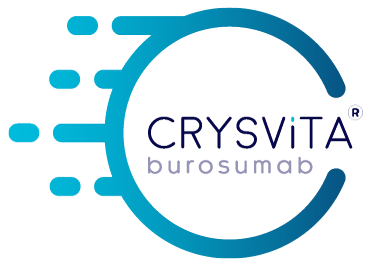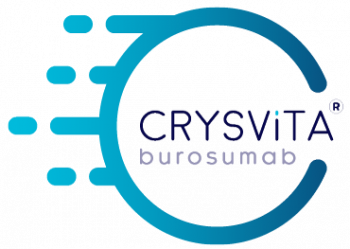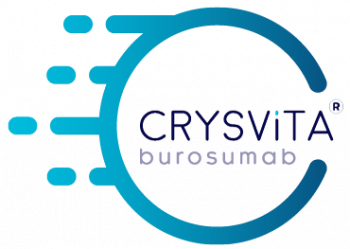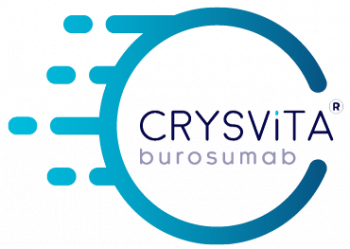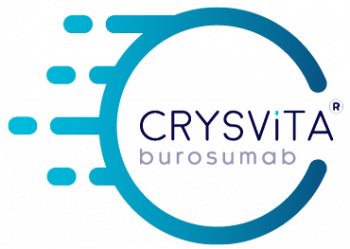Start treatment with CRYSVITA® as early as possible after diagnosis of XLH in suitable patients
Table of Contents
As of 13 December 2022, CRYSVITA® has been approved by Drug Control Authority (DCA), National Pharmaceutical Regulatory Agency (NPRA), Malaysia. To decide if this is a suitable option for any of your patients, please click here for more information.
Product is approved in EU/US/Japan and selected markets in Asia Pacific. Local approved prescribing information may differ. Please refer to local approval status and prescribing information before prescribing.
Dosing
CRYSVITA® dosing is every 2 weeks in Children and Adolescents aged 1 to 17 years1
As of 3 May 2021, CRYSVITA has been approved by Health Science Authority (HSA) Singapore. To decide if this is a suitable option for any of your patients, please click here for more information.
Product is approved in EU/US/Japan and selected markets in Asia Pacific. Local approved prescribing information may differ.
Please refer to local approval status and prescribing information.
Dosing in children and adolescents aged 1 to 17 years is every 2 weeks.
The recommended starting dose in children and adolescents aged 1 to 17 years is 0.8 mg/kg of body weight given every two weeks. Doses should be rounded to the nearest 10 mg. The maximum dose is 90 mg.
After initiating CRYSVITA®, fasting serum phosphate should be measured :
- every 2 weeks for the first month of treatment
- every 4 weeks for the following 2 months and thereafter as appropriate.
Fasting serum phosphate should also be measured 4 weeks after any dose adjustment. If fasting serum phosphate is within the reference range for age, the same dose should be maintained.
Oral phosphate and active vitamin D analogues (e.g. calcitriol) should be discontinued 1 week prior to initiation of treatment. Vitamin D replacement or supplementation with inactive forms may be started or continued as per local guidelines under monitoring of serum calcium and phosphate. At initiation, fasting serum phosphate concentration should be below the reference range for age.
CRYSVITA® dosing is every 4 weeks in adult patients1
The recommended starting dose in adults is 1.0 mg/kg of body weight, rounded to the nearest 10 mg up to a maximum dose of 90 mg, given every 4 weeks.
After initiation of treatment with burosumab, fasting serum phosphate should be measured :
- every 2 weeks for the first month of treatment
- every 4 weeks for the following 2 months and thereafter as appropriate.
Fasting serum phosphate should be measured 2 weeks after the previous dose of burosumab. If serum phosphate is within the normal range, the same dose should be continued.
Oral phosphate and active vitamin D analogues (e.g. calcitriol) should be discontinued 1 week prior to initiation of treatment. Vitamin D replacement or supplementation with inactive forms may be started or continued as per local guidelines under monitoring of serum calcium and phosphate. At initiation, fasting serum phosphate concentration should be below the reference range for age.
Calculation for starting dose
Sample Starting Dose Calculation – Pediatric (1 to <18 years old)
Patient weight (kg) x Recommended starting dose (0.8mg/kg)
Example: 23kg x 0.8mg/kg = 18.4 mg (Round to nearest 10 mg)
Starting dose CRYSVITA® = 20 mg
Sample Starting Dose Calculation – Adult patient (≥18 years of age)
Patient weight (kg) x Recommended starting dose (1mg/kg)
Example: 77kg x 1mg/kg = 77 mg (Round to nearest 10 mg)
Starting dose CRYSVITA® = 80 mg
Pediatrics Dose Adjustments1
Dose Increase (Children and adolescent patients aged 1 to 17 years old)1 :
If fasting serum phosphate is below the reference range for age, the dose may be increased stepwise by 0.4 mg/kg up to a maximum dose of 2.0 mg/kg (maximum dose of 90 mg). Fasting serum phosphate should be measured 4 weeks after dose adjustment.
Crysvita® should not be adjusted more frequently than every 4 weeks.
Table 1. PEDIATRIC DOSE SCHEDULE
Pediatric Dose Schedule for Stepwise Dose Increase
| Body Weight (kg) | Starting Dose (mg) | First Dose Increase to (mg) | Second Dose Increase to (mg) |
|---|---|---|---|
| 10-14 | 10 | 15 | 20 |
| 15-18 | 10 | 20 | 30 |
| 19-31 | 20 | 30 | 40 |
| 32-43 | 30 | 40 | 60 |
| 44-56 | 40 | 60 | 80 |
| 57-68 | 50 | 70 | 90 |
| 69-80 | 60 | 90 | 90 |
| 81-93 | 70 | 90 | 90 |
| 94-105 | 80 | 90 | 90 |
|
| 90 | 90 | 90 |
Dose decrease (pediatric patients 1 to less than 18 years of age)1
Dose Decrease (Children and adolescent patients aged 1 to 17 years old)1 :
If fasting serum phosphate is above the reference range for age, the next dose should be withheld and the fasting serum phosphate reassessed within 4 weeks. The patient must have fasting serum phosphate below the reference range for age to restart Crysvita® at half of the previous dose, rounding the amount as described above.
Table 2. PEDIATRIC DOSE SCHEDULE
Pediatric Dose Schedule for Re-Initiation of Therapy
| Previous Dose (mg) | Re-initiation Dose (mg) |
|---|---|
| 10 | 5 |
| 15 | 10 |
| 20 | 10 |
| 30 | 10 |
| 40 | 20 |
| 50 | 20 |
| 60 | 30 |
| 70 | 30 |
| 80 | 40 |
| 90 | 40 |
Do not adjust CRYSVITA® more frequently than every 4 weeks
Adult Dose Adjustments1
Dose Conversion at age 18 years1 :
Children and adolescents aged 1 to 17 years should be treated using the dosing guidance outlined above. At 18 years of age the patient should convert to the adult dose and dosing regimen as per adult dosing regimen.
Do not adjust CRYSVITA® more frequently than every 4 weeks.
Dose decrease (adults)1
If serum phosphate is above the upper limit of normal range, the next dose should be withheld and the serum phosphate level reassessed within 2 weeks. The patient must have serum phosphate below the normal range before restarting Crysvita®. Once serum phosphate is below the normal range, treatment may be restarted at half the initial starting dose up to a maximum dose of 40 mg every 4 weeks. Serum phosphate should be reassessed 2 weeks after any change in dose.
Table 3. ADULT DOSE SCHEDULE FOR RE-INITIATION OF THERAPY
| Previous Dose (mg) | Re-initiation Dose (mg) |
|---|---|
| 40 | 20 |
| 50 | 20 |
| 60 | 30 |
| 70 | 30 |
|
| 40 |
All patients
To decrease the risk for ectopic mineralisation, it is recommended that fasting serum phosphate is targeted in the lower end of the normal reference range for age (see section 4.4 of the Prescribing Information)
Download the CRYSVITA® Dosing Guide for additional information on initiating, dosing, and administering CRYSVITA®.
Missed or late dosing1
Treatments may be administered 3 days either side of the scheduled treatment date if needed for practical reasons. If a patient misses a dose, burosumab should be resumed as soon as possible at the prescribed dose.
Administration
CRYSVITA® Administration1
CRYSVITA® should be administered subcutaneously by a healthcare provider.1
Discontinue oral phosphate and active vitamin D analogs 1 week prior to initiation of treatment. Fasting serum phosphorus concentration should be below the reference range for age prior to initiation of treatment
CRYSVITA® should be administered subcutaneously.1
Oral phosphate and active vitamin D analogues (e.g. calcitriol) should be discontinued 1 week prior to initiation of treatment. Vitamin D replacement or supplementation with inactive forms may be started or continued as per local guidelines under monitoring of serum calcium and phosphate. At initiation, fasting serum phosphate concentration should be below the reference range for age (see section 4.3 of Prescribing Information).
Method of Administration1
Crysvita® (Burosumab) should be injected in the upper arm, abdomen, buttock or thigh.
The maximum volume of medicinal product per injection site is 1.5 ml. If more than 1.5 ml is required on a given dosing day, the total volume of medicinal product must be split and administered at two or more different injection sites. Injection sites should be rotated and carefully monitored for signs of potential reactions (see section 4.4 of Prescribing Information).
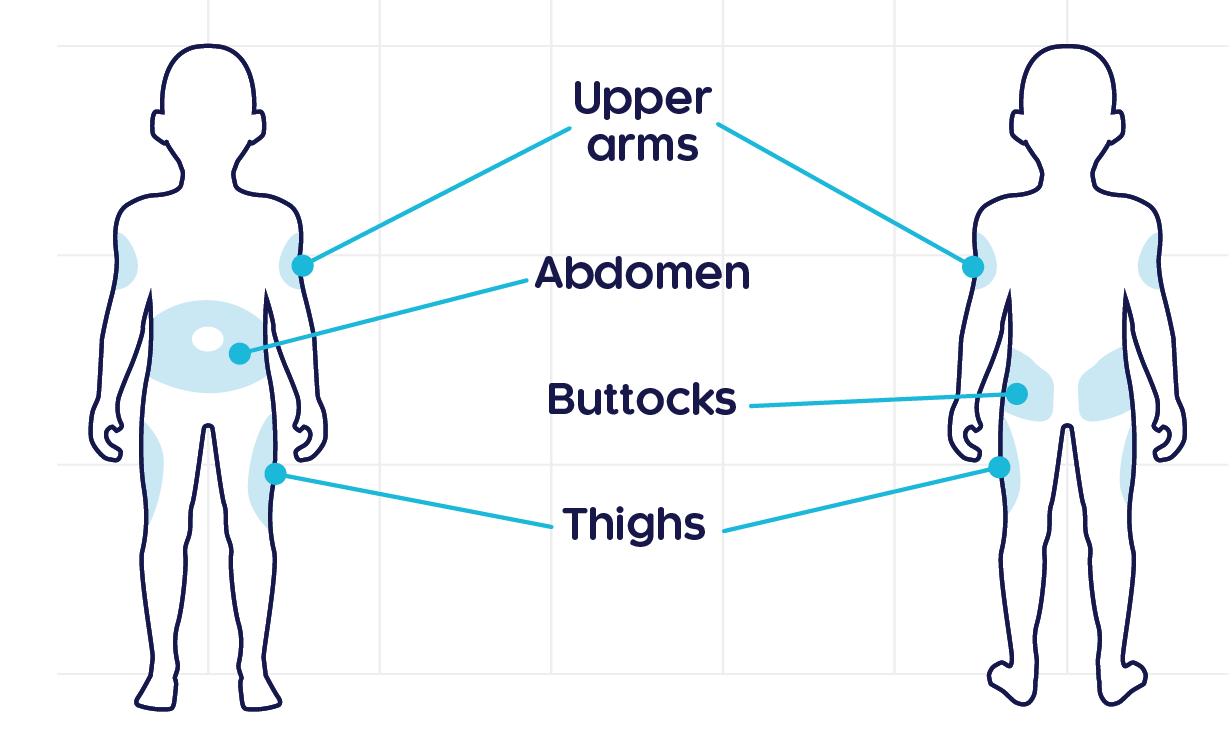
Monitoring
Recommended monitoring schedule for CRYSVITA® patients2
| Assessment | Frequency |
|---|---|
| Fasting serum phosphate† | Month 1: Every 2 weeks |
| Month 2-3: Every 4 weeks | |
| Thereafter: As appropriate | |
|
Following dose adjustment : - 4 weeks after for children and adolescent - 2 weeks after any change in dose for adults | |
| Renal ultrasonography | At least every 2 years in patients without nephrocalcinosis and at yearly intervals in patients with nephrocalcinosis and/or persistent hypercalciuria |
| Plasma ALP, calcium, PTH and creatinine | In children aged 1–5 years: Every 1-3 months, or as indicated |
| In children 5-12 years: Every 3-6 months, or as indicated | |
| Urine calcium and phosphate‡ | Every 3-6 months |
†It is recommended that fasting serum phosphate is targeted at the lower end of the normal reference for age.
‡Upper normal range (mol/mol): 2.2 (<1 years), 1.4 (1–3 years), 1.1 (3–5 years), 0.8 (5–7 years) and 0.7 (>7 years).
Contraindications, warnings and precautions1
Contraindications
- Hypersensitivity to the active substance or to any of the excipients listed in section 6.1 of Prescribing Information
- Concurrent administration with oral phosphate, active vitamin D analogs (see section 4.5 of Prescribing Information).
- Fasting serum phosphate above the normal range for age due to the risk of hyperphosphatemia (see section 4.4 of Prescribing Information)
- Patients with severe renal impairment or end stage renal disease.
Warnings
Traceability
In order to improve the traceability of biological medicinal products, the name and the batch number of the administered product should be clearly recorded within the patient’s records.
Ectopic mineralization
Ectopic mineralization, as manifested by nephrocalcinosis, has been observed in patients with XLH treated with oral phosphate and active vitamin D analogs; these medicinal products should be stopped at least 1 week prior to initiating burosumab treatment (see section 4.2 of Prescribing Information).
Monitoring for signs and symptoms of nephrocalcinosis, e.g. by renal ultrasonography, is recommended at the start of treatment and every 6 months for the first 12 months of treatment, and annually thereafter. Monitoring of plasma alkaline phosphatase, calcium, parathyroid hormone (PTH) and creatinine is recommended every 6 months (every 3 months for children 1 – 2 years) or as indicated.
Monitoring of urine calcium and phosphate is suggested every 3 months.
Hyperphosphataemia
Levels of fasting serum phosphate should be monitored due to the risk of hyperphosphatemia. To decrease the risk for ectopic mineralization, it is recommended that fasting serum phosphate is targeted in the lower end of the normal reference range for age. Dose interruption and/or dose reduction may be required (see section 4.2 of Prescribing Information). Periodic measurement of post prandial serum phosphate is advised.
Serum parathyroid hormone
Increases in serum parathyroid hormone have been observed in some XLH patients during treatment with burosumab. Periodic measurement of serum parathyroid hormone is advised.
Injection site reaction
Administration of burosumab may result in local injection site reactions. Administration should be interrupted in any patient experiencing severe injection site reactions (see section 4.8 of Prescribing Information) and appropriate medical therapy administered.
Hypersensitivity
Burosumab must be discontinued if serious hypersensitivity reactions occur and appropriate medical treatment should be initiated.
Excipient with known effect
This medicine contains 45.91 mg of sorbitol in each vial which is equivalent to 45.91 mg/ml.
Special Populations
Pregnancy
- There are no or limited amount of data from the use of burosumab in pregnant women.
- Studies in animals have shown reproductive toxicity (see section 5.3 of Prescribing Information).
- Burosumab is not recommended during pregnancy and in women of childbearing potential not using contraception.
Breast-feeding
- It is unknown whether burosumab/metabolites are excreted in human milk.
- A risk to newborns/infants cannot be excluded.
- A decision must be made whether to discontinue breast-feeding or to discontinue/abstain from burosumab therapy taking into account the benefit of breast feeding for the child and the benefit of therapy for the woman.
Fertility
Studies in animals have shown effects on male reproductive organs (see section 5.3 of Prescribing Information). There are no clinical data available on the effect of burosumab on human fertility. No specific fertility studies in animals with burosumab were conducted.
Pediatric Population
The safety and efficacy of burosumab in children aged less than one year have not been established in clinical studies.
Elderly
Limited data is available in patients over 65 years of age.
Renal Impairment
CRYSVITA® has not been studied in patients with renal impairment. Burosumab must not be given to patients with severe or end stage renal disease (see section 4.3 of Prescribing Information).
Storage
CRYSVITA® Storage1
Store CRYSVITA® away from light and in refrigerated conditions1
- CRYSVITA® is supplied as a sterile, preservative-free, clear to slightly opalescent and colorless to pale brown-yellow solution for subcutaneous injection. The product is available as one single-dose vial per carton in the following strengths: 10, 20, and 30 mg/mL.*
- Visually inspect CRYSVITA® for particulate matter and discoloration prior to administration.
- Do not use if the solution is discolored or cloudy or if the solution contains any particles or foreign particulate matter.
*Not all presentations may be available locally
CRYSVITA® vials must be stored in the original carton until the time of use under refrigerated conditions at (2°C to 8°C). Keep CRYSVITA® vial in the original carton to protect from light until time of use.
Do not freeze or shake. Do not use CRYSVITA® beyond the expiration date stamped on the carton. CRYSVITA® vials are single-dose only. Discard any unused product.
Please refer to the full Prescribing Information for full details before prescribing.
1. CRYSVITA® (burosumab). Based on Singapore Package Insert. Kyowa Kirin Asia Pacific Pte Ltd; May 2021 2. Haffner D et al. Nat Rev Nephrol. 2019; 15(7): 435–455.
